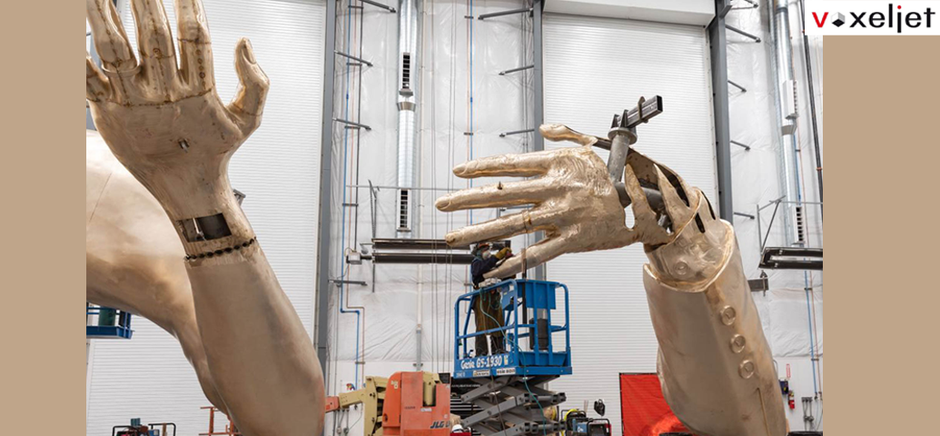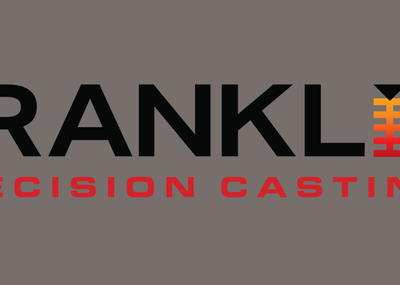A symbolic monument
In 2017, the non-profit organization Embrace Boston launched a design competition seeking a permanent monument honoring the Kings` legacy and presence within the city. The aim was to create a symbol of equitability and inclusivity, working to inspire change and promote social justice in the city of Boston. The design for The Embrace was chosen from 126 submissions by artists and architects as it represents that love is the ultimate weapon against injustice. Afterwards, the work to actually construct the statue began.
Scalability beyond traditional manufacturing
Envisioned as a 6-meter-tall and nearly 8-meter-wide bronze statue, transforming the design into reality required the expertise of architects, engineers, and craftspeople. The go-to manufacturing process for bronze sculptures is the investment casting process. Traditionally, this process requires a full-scale model of the sculptor, carved from clay or would, which then molded is into silicone to produce an imprint of the sculpture. Then, wax is injected into the silicone mold to create a wax model of the sculpture. This model is then repeatedly dipped into a ceramic slurry and covered in sand to create a ceramic shell around the model. The wax can then be melted out of the shell using an autoclave, leaving a cavity in the shell into which the bronze can be casted. It is a multistage and highly complex and filigree process. One can only imagine how complex and long the creation of a full-scale model of the envisioned “The Embrace” would have been. Fortunately, however, there is now a technology that simplifies the traditional investment casting process many times over: 3D printing. Or, to be more precise, PMMA 3D printing.
As with other 3D printing technologies, the design is created and edited digitally. Artists are increasingly using digital design technologies as they allow full design freedom and quick and easy alterations. For the Boston Commons sculpture, the artists also turned to CAD design to create a digital model. Now all that was missing was a foundry to cast the sculpture.
An efficient add-on to traditional foundry technologies
The foundry selected to create the sculpture was the Walla Walla foundry, an expert in fine art casting and fabrication in Washington State, almost 2,500 miles away from Boston. For over 40 years, the foundry has realized sculptural projects in a wide variety of materials and at nearly any scale. Today, Walla Walla is one of the largest contemporary art fabricators in the world, which has lately also been implementing modern technologies such as 3D printing to complement traditional foundry technologies. Among them, two VX1000 PMMA 3D printers from voxeljet.
At Walla Walla, the CAD files were reviewed and scaled by a casting expert. The digital sculpture was then divided into 608 individual pieces. Each of the pieces about the maximum size of our VX1000 binder jet 3D printer: 1000 x 600 x 500 mm. The foundry printed all the patterns on their own systems and was also supported by our Michigan based US facility for additional production. What made our binder jet technology so suitable for the production of the statue was that it allowed the build space to be utilized to the maximum possible filling level while allowing highest precision and details. Walla Walla also printed a complete model of the sculpture to get a view of its proportions and seamlines and to assess the handling of the individual parts.
The 3D printers employ the Binder Jetting 3D printing technology. First, the digital CAD file is sliced digitally into thin layers, each one representing a cross section of the part. Then a recoater applies a 150µm thick layer of PMMA powder onto a building platform which is then selectively printed by a print head. Each representing one cross section of the previously sliced part. These process steps are repeated until the parts are fully printed. They can then be unpacked from the job box, cleaned of any powder residue and post processed. For example, by infiltrating with wax to create a smooth surface.
After the PMMA patterns were printed, they were handled exactly like conventional wax patterns as it is known from traditional investment casting. After building the ceramic shell, the PMMA was melted, leaving behind a hollow cavity in which molten metal – bronze in case of “The Embrace” - is poured. After the metal has solidified, the individual pieces were welded together and patinated. Including the scaffolding that holds everything in place, the final statue weighs 19 tons. The entire production process took two years.
How 3D printing is heralding the future of sculpture
Today, The Embrace stands in the Boston Commons as a testament to justice and progressive change. It will not only be a lasting symbol of the legacy Martin Luther King and his family inherited to the world, it also exemplifies the unparalleled precision and efficiency offered by the combination of modern 3D printing technology with traditional art and investment casting. It is destined to give artists and architects the opportunity to realize monumental visions without the constraints of traditional casting methods.











